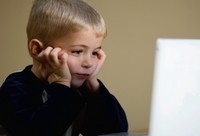
Such conditions can be diagnosed and treated if loss of vision can be detected.
The so-called KidzEyez device is aimed at replacing perimetry systems for testing the field of vision of children between one and five years old, as well as older children and adults with learning difficulties.
The system was developed by Dr Adar Pelah of York University and Dr Louise Allen, a paediatric ophthalmologist at Addenbrooke’s Hospital in Cambridge, in response to concerns that children in this age bracket cannot concentrate on perimetry systems.
These devices use a hemisphere studded with LED lights that are placed in front of the patient. The lights either move inwards until the patient can see them, or flash on and off to detect whether a patient reacts to the change.
Pelah said: ‘Kids get bored quickly and aren’t really interested in the flashing LED lights used in perimetry devices. Rather than having spots of light going on and off, we’ve developed an augmented reality that we believe will keep the child’s attention for longer.’
Working with Masters student, Michael Slater, Pelah has created software that displays virtual reality to a child from a standard computer screen. Moving targets appear and disappear at different intervals based on the position of the child’s eyes, which are tracked using a webcam.
Pelah added: ‘The problem is that children move around a lot. You have to know their position exactly so that you know where on the retina the image will appear. We’ve developed image processing technology that calculates the position of the eyes in relation to the screen in real time. We are then able to generate images that correspond to that information.’
A prototype system is being developed and will begin clinical trials next year. Research students at Cambridge University are helping to commercialise the product and market it to health providers.
Pelah said: ‘In the future, we will increase the level of automation and look at wider research topics to understand not only visual processing, but also visual development in very young children.’




Swiss geoengineering start-up targets methane removal
No mention whatsoever about the effect of increased methane levels/iron chloride in the ocean on the pH and chemical properties of the ocean - are we...